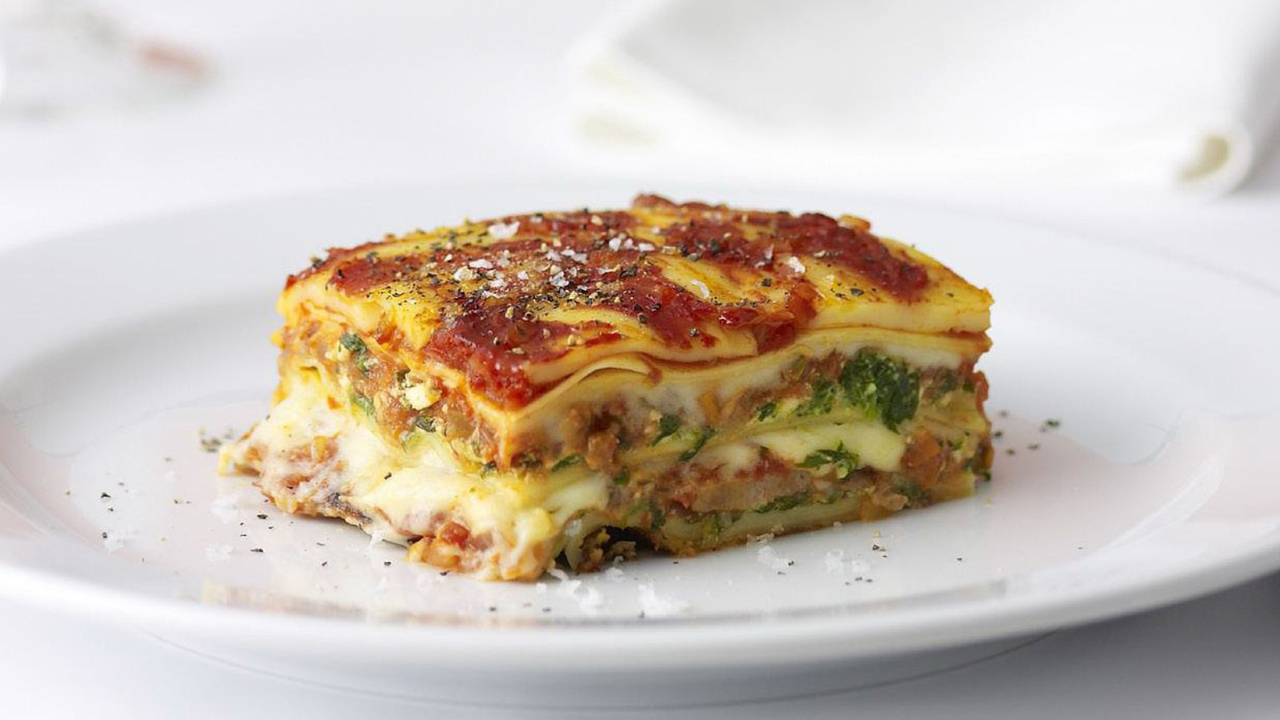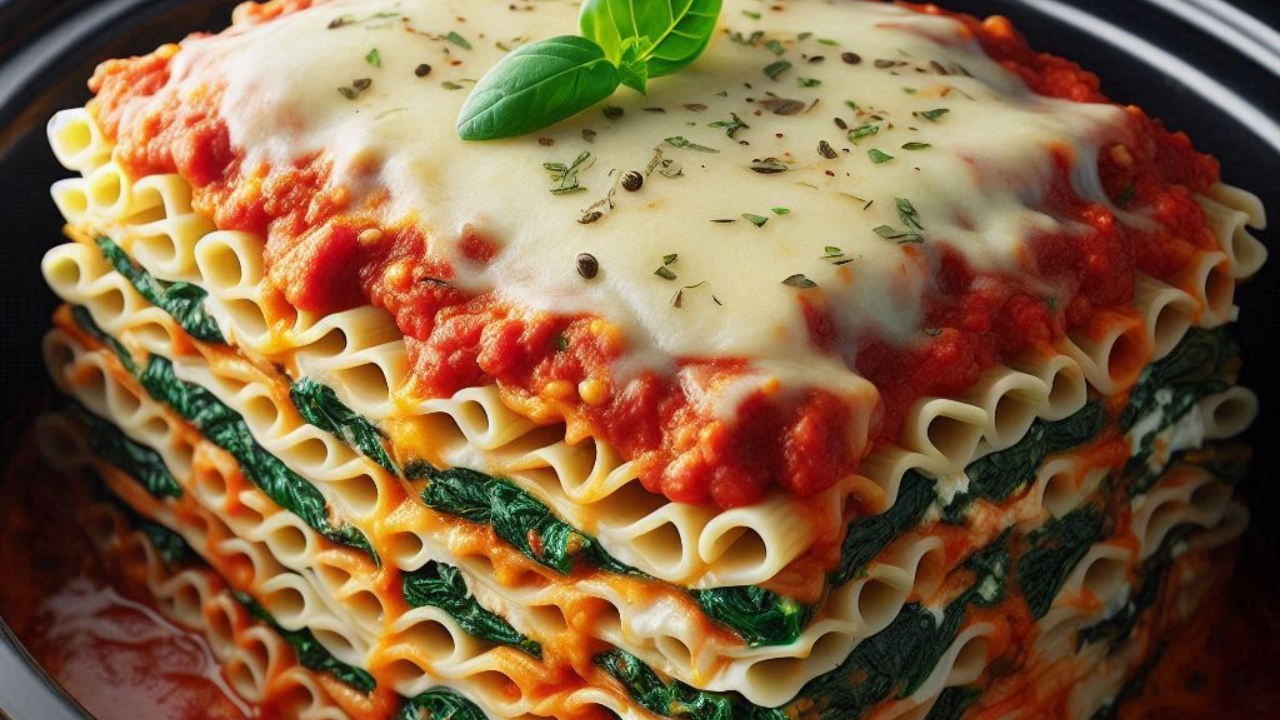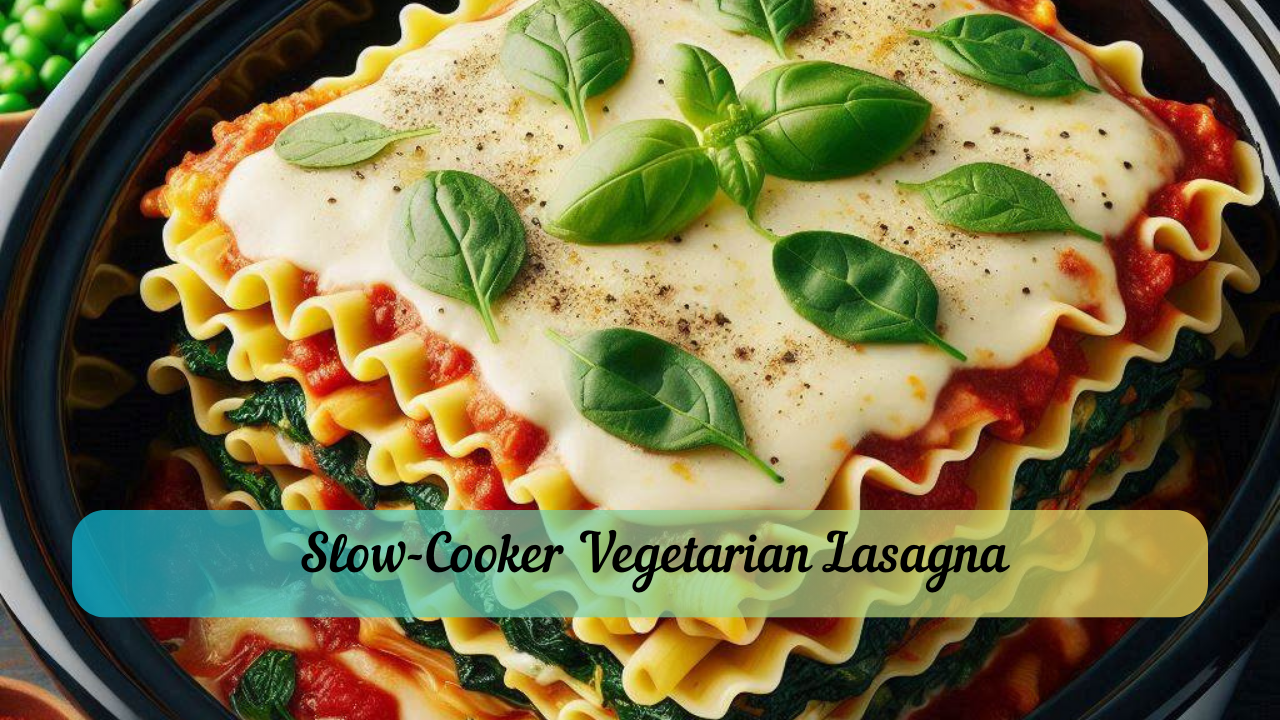Introduction
Slow-cooker vegetarian lasagna is a delightful and hearty dish that’s perfect for those looking to enjoy a meat-free meal without sacrificing flavor or satisfaction. This lasagna combines layers of tender pasta, rich tomato sauce, creamy ricotta cheese, and a medley of fresh vegetables. Using a slow cooker makes the process incredibly convenient, allowing the flavors to meld beautifully over several hours without the need for constant attention. It’s an excellent option for busy weeknights or when you want to prepare a meal in advance.
Ingredients
For the Tomato Sauce
- 2 tablespoons olive oil
- 1 large onion, finely chopped
- 4 cloves garlic, minced

- 2 cans (28 ounces each) crushed tomatoes
- 1 can (6 ounces) tomato paste
- 1 can (14.5 ounces) diced tomatoes
- 2 teaspoons dried basil
- 2 teaspoons dried oregano
- 1 teaspoon salt
- 1/2 teaspoon black pepper
- 1 tablespoon sugar (optional, to balance acidity)
For the Ricotta Mixture
- 2 cups ricotta cheese
- 1 cup grated Parmesan cheese
- 1 egg, lightly beaten
- 1/4 cup chopped fresh basil (or 1 tablespoon dried basil)
- 1/4 cup chopped fresh parsley (or 1 tablespoon dried parsley)
- Salt and pepper to taste
For the Vegetables
- 2 cups sliced mushrooms
- 2 cups chopped spinach (fresh or frozen, if using frozen, thaw and drain well)
- 1 large zucchini, sliced into thin rounds
- 1 large bell pepper, chopped
- 1 medium eggplant, thinly sliced (optional)
- 1 cup grated carrots
For Assembly
- 12-15 lasagna noodles (no-boil or regular, broken to fit the slow cooker)
- 4 cups shredded mozzarella cheese
- 1 cup grated Parmesan cheese
Preparation Steps
Watch The Full Recipe Video:
Step 1: Prepare the Tomato Sauce
- Sauté the Aromatics: Heat the olive oil in a large skillet over medium heat. Add the chopped onion and sauté until it becomes translucent, about 5 minutes. Add the minced garlic and cook for another 1-2 minutes until fragrant.
- Combine the Tomatoes: Add the crushed tomatoes, tomato paste, and diced tomatoes to the skillet. Stir well to combine.
- Season the Sauce: Stir in the dried basil, dried oregano, salt, pepper, and sugar (if using). Let the sauce simmer for about 20 minutes, allowing the flavors to meld together. Taste and adjust the seasoning if needed.
Step 2: Prepare the Ricotta Mixture
- Combine Ingredients: In a large bowl, mix together the ricotta cheese, grated Parmesan cheese, beaten egg, chopped basil, chopped parsley, salt, and pepper until well combined. Set aside.
Step 3: Prepare the Vegetables
- Prepare the Vegetables: Clean and chop all the vegetables as directed. For the spinach, if using fresh, chop it finely. If using frozen spinach, make sure it is thawed and drained thoroughly to remove excess moisture.
Step 4: Assemble the Lasagna in the Slow Cooker
- Layer the Ingredients: Begin by spreading a thin layer of the tomato sauce at the bottom of the slow cooker to prevent the noodles from sticking.
- First Layer of Noodles: Place a layer of lasagna noodles on top of the sauce, breaking them as necessary to fit the shape of the slow cooker.

- First Layer of Ricotta Mixture: Spread a portion of the ricotta mixture over the noodles.
- First Layer of Vegetables: Add a layer of mixed vegetables on top of the ricotta mixture.
- Cheese Layer: Sprinkle a portion of shredded mozzarella cheese over the vegetables.
- Repeat Layers: Repeat the layers of sauce, noodles, ricotta mixture, vegetables, and mozzarella cheese until all the ingredients are used up. The final layer should be a generous amount of sauce topped with mozzarella cheese and grated Parmesan.
Step 5: Cook the Lasagna
- Slow Cook: Cover the slow cooker with its lid and cook the lasagna on low for 4-6 hours. The exact cooking time can vary depending on your slow cooker model. The lasagna is done when the noodles are tender, and the cheese is melted and bubbly.
Tips for Perfect Slow-Cooker Vegetarian Lasagna
- Use Fresh Vegetables: Fresh vegetables bring a vibrant flavor and texture to the lasagna. However, frozen vegetables can be used if you prefer. Just make sure to thaw and drain them well to avoid excess moisture.
- Don’t Overload the Slow Cooker: Layer the ingredients evenly and avoid overfilling the slow cooker. This ensures even cooking and prevents the lasagna from becoming too watery.
- Check for Doneness: Around the 4-hour mark, check the lasagna to see if the noodles are cooked through. If they are still firm, continue cooking and check every 30 minutes until they reach the desired texture.
- Let It Rest: Once the lasagna is done, turn off the slow cooker and let it rest for about 15-20 minutes before serving. This helps the layers set and makes it easier to slice.
- Customize the Vegetables: Feel free to add or substitute vegetables based on your preferences. Other great additions include sliced bell peppers, shredded carrots, or even thinly sliced butternut squash.
- Add Fresh Herbs: Fresh herbs like basil, parsley, or thyme can elevate the flavor of the lasagna. Sprinkle some fresh herbs over the top before serving for a burst of freshness.
- Use No-Boil Noodles: If you’re short on time, you can use no-boil lasagna noodles. They will cook perfectly in the slow cooker, absorbing the flavors of the sauce and vegetables.
Serving Suggestions

- Side Salad: Serve the lasagna with a fresh green salad dressed with a simple vinaigrette. The crispness of the salad complements the rich, cheesy lasagna.
- Garlic Bread: Garlic bread or a crusty baguette is perfect for mopping up any extra sauce.
- Wine Pairing: A glass of red wine, such as Chianti or Pinot Noir, pairs wonderfully with the flavors of the lasagna.
- Dessert: Finish the meal with a light dessert like a fruit sorbet or a slice of lemon tart.
Storing and Reheating
- Storing: Leftover lasagna can be stored in an airtight container in the refrigerator for up to 3-4 days.
- Freezing: For longer storage, you can freeze individual portions of lasagna. Wrap each portion tightly in plastic wrap and aluminum foil before placing it in a freezer-safe bag. It can be frozen for up to 3 months.
- Reheating: To reheat, place a portion of lasagna in a microwave-safe dish and cover it with a microwave-safe lid or wrap. Heat on medium power until warmed through. Alternatively, you can reheat it in the oven at 350°F (175°C) for about 20-25 minutes.
Nutritional Benefits of Slow-Cooker Vegetarian Lasagna
Slow-Cooker Vegetarian Lasagna offers a variety of nutritional benefits thanks to its combination of vegetables, cheese, and pasta. Here are some of the key benefits:
1. Rich in Vegetables
The lasagna is packed with a variety of vegetables like spinach, mushrooms, zucchini, bell peppers, and eggplant. These vegetables provide essential vitamins, minerals, and antioxidants that contribute to overall health.
- Spinach: High in vitamins A, C, and K, folate, iron, and calcium.
- Mushrooms: A good source of B vitamins, selenium, and potassium.
- Zucchini: Rich in vitamin C, manganese, and dietary fiber.
- Bell Peppers: Excellent source of vitamins A and C, folate, and fiber.
- Eggplant: Contains fiber, vitamins B1 and B6, and antioxidants like nasunin.
2. High in Fiber
The vegetables and whole grains (if you choose whole-grain lasagna noodles) contribute to the high fiber content of this dish. Fiber is crucial for maintaining a healthy digestive system, regulating blood sugar levels, and lowering cholesterol.
3. Protein-Rich
While this lasagna is vegetarian, it still offers a good amount of protein, mainly from the cheese. Ricotta, mozzarella, and Parmesan provide complete proteins that are essential for muscle repair and growth. If you add tofu or plant-based protein, the protein content increases further.
4. Calcium and Bone Health
The cheeses used in the lasagna are rich in calcium, which is essential for maintaining strong bones and teeth. A single serving of lasagna can provide a significant portion of the daily recommended intake of calcium.
5. Antioxidants

Vegetables in the lasagna are loaded with antioxidants, which help combat oxidative stress and inflammation in the body. Antioxidants like vitamins C and E, beta-carotene, and various phytonutrients support immune function and may reduce the risk of chronic diseases.
6. Iron
Ingredients like spinach and mushrooms contribute to the iron content of the lasagna. Iron is essential for the production of hemoglobin, which transports oxygen in the blood. Including vitamin C-rich foods like bell peppers helps enhance iron absorption from plant-based sources.
7. Low in Saturated Fat (Optional)
By choosing low-fat or part-skim versions of cheeses, you can reduce the saturated fat content of the lasagna. This makes it a heart-healthier option compared to traditional meat lasagnas.
8. Vitamins and Minerals
The variety of vegetables and the tomato sauce provide a broad spectrum of vitamins and minerals:
- Tomatoes: High in vitamin C, potassium, folate, and lycopene, an antioxidant linked to many health benefits.
- Onions and Garlic: Rich in vitamins C and B6, and compounds like allicin that have antimicrobial properties.
9. Low Glycemic Index
Using whole-grain noodles can help keep the glycemic index of the lasagna lower, which is beneficial for managing blood sugar levels and maintaining steady energy.
10. Customization for Specific Nutritional Needs
The flexibility of this recipe allows for customization based on dietary needs:
- For additional protein, add plant-based proteins like lentils, chickpeas, or tofu.
- For more fiber, use whole-grain lasagna noodles and add more fibrous vegetables.
- For reduced fat, opt for part-skim or low-fat cheese options.
- For a vegan option, use dairy-free cheese alternatives and ensure the pasta is egg-free.
FAQs:
1. Can I use regular lasagna noodles in a slow-cooker lasagna?
Yes, you can use regular lasagna noodles in a slow-cooker lasagna. There’s no need to pre-cook them. The slow cooking process allows the noodles to absorb the moisture from the sauce and vegetables, resulting in perfectly cooked noodles by the end.
2. Can I make this lasagna gluten-free?
Absolutely. To make this lasagna gluten-free, simply use gluten-free lasagna noodles. Ensure that all other ingredients, especially the sauces and cheeses, are also gluten-free.
3. Can I add other vegetables to the lasagna?
Yes, you can customize the vegetable mix to suit your preferences. Good additions include bell peppers, carrots, broccoli, kale, or even thin slices of sweet potato or butternut squash.

4. Can I prepare the lasagna the night before and cook it the next day?
Yes, you can assemble the lasagna the night before and refrigerate it. When you’re ready to cook, simply place the slow cooker insert back into the base and cook as directed. Keep in mind that if it’s been refrigerated, it might need a little extra cooking time.
5. Can I use store-bought sauce instead of making my own?
Yes, using store-bought sauce can save time. Choose a high-quality marinara or tomato sauce that you enjoy. You’ll need about 5-6 cups of sauce for this recipe.
6. How do I prevent the lasagna from becoming too watery?
To prevent a watery lasagna, make sure to thoroughly drain any canned vegetables and squeeze out excess moisture from thawed frozen vegetables. Also, avoid overloading the slow cooker with too many vegetables. If your sauce seems particularly watery, simmer it longer before layering to reduce the liquid content.
7. How do I know when the lasagna is done?
The lasagna is done when the noodles are tender, and the cheese is melted and bubbly. Around the 4-hour mark, check the noodles with a fork. If they are still firm, continue cooking and check every 30 minutes.
8. Can I add meat to this lasagna?

While this recipe is designed to be vegetarian, you can add meat if you prefer. Brown some ground beef, turkey, or sausage and add it to the tomato sauce. Ensure the meat is fully cooked before layering it into the lasagna.
9. How can I make this lasagna vegan?
To make this lasagna vegan, use dairy-free ricotta, mozzarella, and Parmesan cheese alternatives. There are many plant-based cheese options available. Also, ensure that the lasagna noodles and sauces are vegan.
10. Can I use fresh spinach instead of frozen?
Yes, you can use fresh spinach. Chop it finely before adding it to the lasagna. If using frozen spinach, make sure it is thawed and well-drained to remove excess moisture.
11. What size slow cooker should I use?
A 6-quart slow cooker is ideal for this lasagna recipe. It provides enough space for the layers and ensures even cooking. If your slow cooker is smaller, you might need to reduce the quantities or adjust the layering technique.
12. How do I store leftover lasagna?
Store leftover lasagna in an airtight container in the refrigerator for up to 3-4 days. To freeze, wrap individual portions tightly in plastic wrap and aluminum foil, then place in a freezer-safe bag. Frozen lasagna can be stored for up to 3 months.
13. How do I reheat the lasagna?
To reheat, place a portion of lasagna in a microwave-safe dish and cover it with a microwave-safe lid or wrap. Heat on medium power until warmed through. Alternatively, you can reheat it in the oven at 350°F (175°C) for about 20-25 minutes.
14. Can I double the recipe?
Doubling the recipe can be challenging because most slow cookers won’t have enough space for the extra volume. Instead, consider making two separate batches if you need to serve more people.
15. Do I need to grease the slow cooker?
Yes, it’s a good idea to lightly grease the inside of the slow cooker with cooking spray or a little olive oil. This helps prevent the noodles from sticking and makes cleanup easier.

16. Can I add tofu or other plant-based proteins?
Yes, adding tofu or other plant-based proteins like lentils or chickpeas can boost the protein content of the lasagna. Crumbled tofu mixed with some seasonings can be layered with the vegetables for added texture and nutrition.
17. How can I enhance the flavor of the lasagna?
To enhance the flavor, consider adding a splash of red wine to the tomato sauce or incorporating roasted garlic. Fresh herbs like basil and oregano, added just before serving, can also provide a flavor boost.
18. Can I use a different type of cheese?
Feel free to experiment with different cheeses. Provolone, fontina, or a blend of Italian cheeses can add unique flavors to your lasagna. Just ensure the cheese melts well and complements the other ingredients.
19. Is there a way to make the lasagna spicier?
For a spicier lasagna, add red pepper flakes or diced jalapeños to the tomato sauce. You can also use a spicy marinara sauce or sprinkle in some cayenne pepper to taste.
20. Can I use bechamel sauce instead of ricotta?
Yes, you can use a bechamel sauce instead of ricotta for a different texture and flavor. Prepare a traditional bechamel sauce and layer it with the noodles and vegetables as you would with the ricotta mixture.
Conclusion
Slow-cooker vegetarian lasagna is a fantastic dish that brings together the comfort of traditional lasagna with the convenience of slow cooking. It’s packed with wholesome vegetables, rich tomato sauce, and creamy cheeses, making it a delicious and satisfying meal for vegetarians and meat-eaters alike. By following these steps and tips, you can create a lasagna that’s full of flavor and perfect for any occasion. Whether you’re serving it for a family dinner or preparing it ahead for a busy week, this lasagna is sure to become a favorite in your household. Enjoy!

